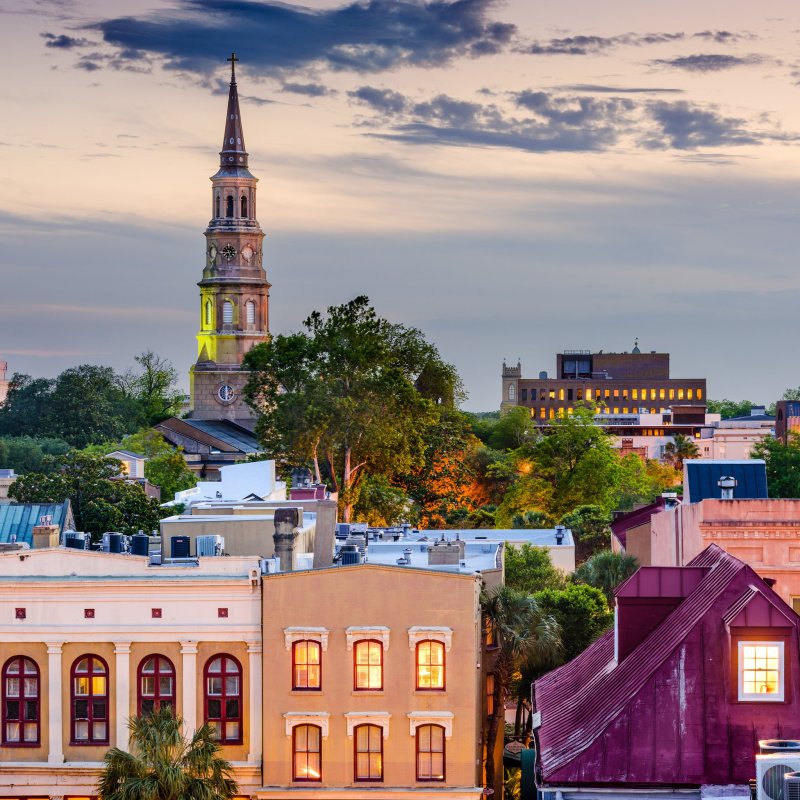
If you’ve never visited Charleston, South Carolina, you are missing out. Charleston feels like a historical time capsule with a modern vibe. The port city, founded in 1670, has original cobblestone streets, horse-drawn carriage rides, and charming neighborhoods lined with antebellum mansions. It is a fantastic foodie destination that has an incredible bar scene (especially on the rooftops). If you like shopping, there are boutiques galore on King Street, and if you love history, there are a variety of tours of all the impressive sites both on land and on the water.
Videos by TravelAwaits
Charleston is an exciting town at any time of year, but in the fall, when the weather is absolutely perfect, you will experience everything the so-called Holy City has to offer at the ideal temperature to enjoy it all. This list is in no particular order, but it is a great start to get to know classic Charleston.
Note: ExploreCharleston hosted many of our Charleston experiences, including our Lowcountry meals (one was offered in tandem with Husk Restaurant). All opinions are my own.

1. Book A Ghost Tour
Bulldog Tours offers ghost and graveyard tours, which are perfect for kicking off the spooky season. Charleston is an old city with a ton of history. It is known as one of the most haunted places in America. Even though they run year-round, the fall is a terrific time to take a ghost and graveyard tour as it affords you exclusive access to one of Charleston’s oldest graveyards after dark.
Our guide was a fantastic storyteller and kept us fascinated with scary tales as we walked through cemeteries and past Saint Michael’s Church, one of Charleston’s oldest surviving religious structures. Our evening concluded in an alleyway, the sight of a duel where the unfortunate loser still whistles an unhappy tune.

If you prefer a different perspective, Sandlapper Tours offers the only ghost tour of Charleston by boat. Your evening sail around the harbor starts when the sun goes down. Then your host will share tales of pirates, their misdeeds, and subsequent hangings in White Point Garden at the tip of the Battery or more recent stories about ghosts who lost their lives out on the water or just along the waterfront. The view from the harbor is breathtaking, and while the anecdotes are spine-tingling, you will also marvel at the beauty of the twinkling lights against the night sky.
Pro Tip: Wear comfortable shoes for the walking tour as you will be on uneven ground at night. Bring a sweater for the boat tour as it gets chilly on the water in the evening.

2. Take A Historic Walking Tour
The best way to see a city is on foot and with an expert guide. My guide, Ann Garris, with Bulldog Tours, was born and raised in Charleston. She knew so much about the city’s history and had insider information about the antebellum homes and their inhabitants. Her 2-hour tour flew by as we walked through the neighborhoods and Ann discussed the prominent families from the past.
We strolled down some of the oldest streets south of Broad and along the Battery, where we learned about Fort Sumter, and how the Civil War was initiated. Our small group discovered the history, mystery, and preservation of this charming peninsula.

Our time came to an end at one of the oldest houses in Charleston: 17 Chalmers Street. The Pink House was built around 1712. Known as a tavern and brothel back then, it is now a private residence. After all this time, it has survived hurricanes, earthquakes, wars, and fires.
Pro Tip: Wear light clothing as it gets warm during fall days and wear comfortable shoes. It also helps to have water to sip along the way.

3. Dine At A Lowcountry Restaurant
Husk Restaurant takes local ingredients and reinterprets them in a modern way. All the ingredients come from the region, so if it doesn’t grow in the South, it doesn’t end up on your plate. Menus are also crafted from local farms and purveyors, so what’s in season is what’s featured. Here you will taste the South, from the ingredients to the preparation to the Southern hospitality. This is slow food at its best.
Start with a cocktail from a dedicated master bartender. Husk’s drink menu reflects both historic and modern spirits from the Southern table. Then order a starter to munch on.
This is a foodie city, and the freshest shellfish and seafood are pulled right from the waters around Charleston. The fall is a perfect season to try the bounty of the region.
Pro Tip: You will need a reservation to eat at Husk. If there are none available, stop by the bar and enjoy a drink and an appetizer. It’s a must-stop in Charleston.

4. Step Back In Time At The Edmondston-Alston House
Several preserved homes in the city are museums open to tourists. All are beautiful and offer a glimpse into life during the antebellum period in Charleston’s history. The Edmondston-Alston House is unique in that it offers magnificent views of the harbor from its piazza. It was built in 1825 by Scottish shipping merchant Charles Edmondston and was the first to be constructed along the sea wall. After the recession in 1837, he sold the property to Charles Alston, who renovated the house in the Greek Revival Style.
General P.G.T. Beauregard watched from the piazza as his troops bombarded Fort Sumter on April 12, 1861. This act signaled the start of the Civil War. The house remains in the Alston family. Many of their possessions, including books, furniture, and paintings, are in the house today. The museum is managed by the Middleton Place Foundation, a not-for-profit educational trust.
Pro Tip: Middleton Place is connected to the Edmondston-Alston House by family ties and is home to America’s oldest landscaped gardens. Henry Middleton, a President of the First Continental Congress, built Middleton and left it to his son Arthur Middleton, a signer of the Declaration of Independence. Later, Williams Middleton, a signer of the Ordinance of Secession, occupied the plantation.

5. Visit Middleton Place
There are six different plantations near Charleston accessible by tour or rental car. While each admission ticket showcases the homes, homeowners, and enslaved people who worked on the plantations, every house has something unique to offer. Middleton Place is a National Historic Landmark. It is the home of America’s oldest landscaped gardens, the Middleton house museum, a living history stableyard, and African American Heritage programs. The home is filled with original artifacts from the Middleton family, including furniture, silver, china, books, and historical documents.
I saw a note signed by Abraham Lincoln for a Middleton family member to pass through Union lines. There are portraits of the Middletons that grace the gentleman’s guest wing walls, the only surviving building out of three structures left standing after the Civil War and subsequent earthquake.
The gardens are from the 18th century and are symmetrical in design. There are stunning water features like the mirror Butterfly Lakes with views over the Ashley River, and in the fall, the camellia sasanqua are in bloom.

After touring the gardens, house, and living history stables, stop in at the Eliza’s House exhibit. The house (circa 1870) once stood where the Middleton Place Restaurant is now. Eliza’s House was occupied by people enslaved at Middleton and later by Freedmen and was opened as a museum in 1991.
This museum tells the true story of the enslaved people who lived and worked the land at Middleton based on research by historian Barbara Doyle, curator Mary Edna Sullivan, and Tracy Todd, a vice president of the Middleton Place Foundation. The research, discovered from looking through archival records, capturing oral histories, and documenting stories from descendants “commemorates and documents in a most personal way” the lives of seven generations of African Americans at Middleton Place.

Once you have seen all these incredible pieces of American history, you might want to stay for a meal. The Middleton Place Restaurant serves an authentic Lowcountry lunch made from local, seasonal, organic ingredients harvested daily from the onsite farm and gardens. Lowcountry favorites like she-crab soup and fried chicken with collard greens and cornbread are served daily. Guests are treated to exquisite views of the garden, Azalea Hill, and the mill pond from the restaurant windows.
Pro Tip: The tours will take a few hours, so make a day of this important landmark. The restaurant does not take reservations for lunch, but it does for dinner. It is well worth the trip.
6. Drink At A Rooftop Bar
The rooftop bar at The Vendue boutique hotel was named Charleston’s number one rooftop bar. It is an excellent spot for a meal or a cocktail, and the visit includes Charleston Harbor and Waterfront Park views. The vistas are incredible either during the day or in the evening when the lights make the city magical. It’s worth a trip to the roof to get a bird’s-eye view of all the church steeples and important landmarks. The cooler evenings in the fall make it the perfect time to sip and sit awhile.
Pro Tip: The rooftop bar doesn’t take reservations, but if it’s crowded, put your name on the list and walk around the lobby to view the rotating exhibit, which showcases over 300 pieces of art.
7. Discover The Story Of Charleston Through Art
The Gibbes Museum’s collection showcases the status of America’s earliest art collectors. Alongside Philadelphia, Boston, and New York, Charleston was one of the wealthiest cities in 1790 because of its rice and indigo exports. It was also a melting pot of cultures, religions, and traditions due to slavery and the subsequent war that divided the country.
In 1888, Charles Gibbes endowed an art museum in Charleston to heal the nation through art. The permanent collections, which span four centuries, include paintings, sculptures, miniature portraits, and decorative art objects. There are also six to eight special exhibitions. The program strives to “promote creativity, introduce new art forms, provide perspective on community issues, encourage freedom of thought, and connect with the broadest possible audience.”
If you are an art lover, a history lover, or a person who wants a peek at the opulence of the treasure trove of the planter’s wealth (accumulated during their prominence) this is a stop you should make.
Pro Tip: The Gibbes is a small museum and can be enjoyed in 1 or 2 hours. It is best to visit during the latter part of the afternoon as a respite from the heat. It is an inspiring experience.
Related Reading:
